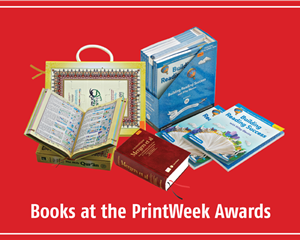Amar Chitra Katha — How comics are keeping print alive
Amar Chitra Katha (ACK) continues to print lakhs of comic books each month through a finely tuned system rooted in legacy, paper choices, and human oversight. In one of her final interviews as president and CEO of ACK, Preeti Vyas speaks to Anhata Rooprai
28 May 2025 | By Anhata Rooprai
For many who grew up in India — or in Indian households abroad — during the latter half of the twentieth century, Amar Chitra Katha (ACK) wasn’t just a comic book series; it was part of growing up. Since its beginnings in the 1960s, the series has served as an introduction to India’s mythology and history.
The idea took shape when Anant Pai, affectionately known as Uncle Pai, noticed that Indian children could answer questions on Greek mythology but struggled with their own history. That inspired him to create a series of illustrated stories rooted in Indian tradition.
With over 100-million copies sold and nearly four-million more purchased annually even today, ACK has played an unmistakable role in shaping how generations view the nation’s past and its mythic imagination.
How it’s made: Then and now
The comic-making process in the 1960s was slow and physical. Artists worked with just 24 watercolour shades, and every part of the book — sketches, colouring, lettering — was done by hand.
“Everything was rendered manually,” says Preeti Vyas, president and CEO of ACK. “If the letterer made a mistake, they’d have to cover it with white ink and do it again. It demanded incredible precision.”
Today, it is a blend of analogue skill and digital convenience. Artists still begin with hand-drawn sketches, often using digital tablets like Wacom. The final artwork is completed in Adobe Photoshop or Illustrator, where colour palettes and textures are virtually limitless.
Once finalised, print-ready high-resolution files are packaged with fonts and layers and sent off for printing. ACK prints with multiple printers, primarily in Mumbai and Manipal, through long-standing, decades-long partnerships with printers such as Indigo Press, True Colour Print, Prasad Designer, and Manipal Technologies.
“Our printers are more than service providers,” says Vyas. “Some of them have been with us since Uncle Pai’s time and know our content in and out. Their knowledge is incredible, and they are almost part of our extended family.” Vyas also acknowledges the ACK’s operations and production team, “They are experts when it comes to understanding the print DNA of an ACK and the Tinkle comics.”
.png)
This team consists of (l-r) Sagar Sawant, head of operations; Dhanad Patil, head of production; and Prasad Ghadigaonkar, senior executive of production.
The comics are produced using four-colour printing on every page. Unlike other publishers who rely on sporadic illustrations, ACK’s panels are entirely visual, making print quality crucial. “We use full-colour printing throughout,” Vyas explains. “That means the way ink behaves, how it bleeds, how it settles — it all has to be closely controlled.”
To meet scale and speed requirements, the team now relies heavily on web-offset printing. The bigger challenge lies with paper.
Planning every page, every week
With the paper market in constant flux, ACK’s team must adapt month to month. The responsibility for production planning lies directly with Vyas. “Based on the demand, orders from the market and the available funds, we decide how much to print and what the budget allocation is,” she says. “We have a production review meeting every Monday. We prioritise carefully — we can’t print the entire catalogue and just warehouse it, that would not make economic sense. We have to be prudent about both – the choice of titles and the quantities to print.”
The top priority is what the team calls “hero products” popular titles like the Ramayana, the Mahabharata, Tinkle Gold, the monthly Tinkle magazine (now in its 45th year of publication), and the brand’s anthology collections. These bring in more than 15% of revenue and are never allowed to go out of stock.
.png)
ACK's legacy titles: The Ramayana and the Mahabharata box sets
Some sets, like the six-volume Mahabharata, take up to two and a half months to produce, with hardbound formats, ribbon markers and elaborate packaging. ACK uses inventory thresholds and automated triggers to decide when to reprint.
ACK currently manages around 600 SKUs. It’s not a massive number by publishing standards, but the complexity lies in creating kits, where one comic may be part of multiple box sets. “It’s like solving a big puzzle,” Vyas says. “If even two of the 210 titles in our Ultimate Collection are unavailable, we can’t ship it. The entire box becomes unsellable.”
The production is driven by a monthly budget. Once the top-priority hero products are covered, the team focuses on new releases and recent titles from the past two years that require visibility. “There’s a widespread belief that we only sell old Uncle Pai books,” says Vyas. “But we’ve created so many new titles. The legacy books sell themselves, but the new ones need a slight push.” To help retailers stock new titles, ACK runs trade schemes like buy 100, get five free offers.
.png)
Preeti Vyas: The legacy books sell themselves, but the new ones need a slight push
Selling stories: Retail versus online
Print continues to lead the way in sales, with physical books accounting for roughly 65% of ACK’s revenue. These reach customers through physical stores that range from independent bookstores to large chains like Crossword and Sapna Book House.
Tinkle magazine is also supplied through a network of newspaper vendors and distributors of periodicals. “We’re in 112 Crossword stores, 24 Sapna locations, and at airports through WHSmith, Higginbotham’s, and Relay,” Vyas notes. “We also have an active direct-to-consumer website, a subscription channel and are on Amazon, for our printed books.”
While the pandemic forced a pivot to digital, the brand emerged with a hybrid strategy. Two apps host a wide library of titles, and digital drops like Tinkle Gold proved hugely popular. “When the lockdown ended, we realised our print-first audience had missed these stories,” Vyas says. “So, we brought them into print. Now, Tinkle Gold is published once or twice a year in physical form.”
| PAPER TRAIL | ||
|---|---|---|
| Title | Text Paper | Cover Paper |
| ACK Singles | 78-gsm TA Maplitho paper | 170-gsm C2C Bilt art paper |
| Specials (like Lakshmi) | 90-gsm matt art paper | 170-gsm C2S Bilt art paper |
| Ramayana, Mahabharata | 78-gsm Paper Plus (imported Maplitho) | 170-gsm C2S + 120-gsm Sunshine |
| Tinkle magazine | 52-gsm Holmen View | 130-gsm C2S art paper |
| Post-press embellishments | Raised UV, spot UV, abrasion, embossing, foil stamping, and foil-border combinations | |
Copyright and creative control
ACK has been tackling artificial intelligence (AI) deftly. The team is already using it to speed up colouring, create marketing assets, and accelerate timelines. “Translation used to take a month, now it takes a few days,” says Vyas. “It doesn’t reduce jobs but expands our capacity.”
That said, piracy remains a real threat. Entire folders of ACK comics have been found shared online, often under the nostalgic guise of forgotten classics. “In one case, a Telegram group was distributing our books daily,” Vyas recalls. “Our team joined the group quietly, documented offenders, and issued legal notices. That shut it down.”
Then there are the derivatives like Khuni Suppandi, a dark reinterpretation of ACK’s classic character that was released online by an independent artist. “We told the artist — please create your own characters if you want to go dark, and sent him a legal notice to take it down when he would not renege” she says. “Suppandi is for children. It’s not about censorship; it’s about creating responsible content, and protecting our intellectual property, which has been built over four decades.”
In a world dominated by screens, ACK continues to thrive. Guided by meticulous planning and a belief in storytelling, it blends tradition with technology to keep the magic of print alive with every carefully crafted comic.












 See All
See All